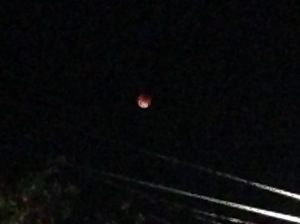So, I’ve been trying to figure out some clever, magical relationship between the three rare Super Full Moon Eclipses I’ve lived through, and keep coming up short. The inspiration? Out of the five super moon eclipses of the twentieth century, three place prominently in my life:
- The third recorded super full moon eclipse occurred the year of my birth, 1946 (December 8 – I was two days shy of being one month old).
- The fourth super full moon eclipse occurred the year of my graduation from high school, 1964.
- The fifth super full moon eclipse occurred the year my daughter was born, 1982.
I think you can understand my fascination. Or perhaps not. I’m probably more obsessed with finding obscure relationships between seemingly disparate or unrelated phenomena than the average person. It’s a vestige of scientific—or mathematic—inquiry left over from my formative years when trying to determine what my gainful occupation would be based on my intellectual proclivities. Writing was always in the picture but never did I imagine at eighteen that I would be a writer. Artists don’t write for money; they write because it’s a passion, an act they cannot help but perform. Being an artist is like living in a cloud with the sheerest of silver linings.
The other dates in the paradigm are 1910 and 1928. Those years, so far, are meaningless to me. My dad was born in 1917 and never graduated high school. My mom was born in 1921 and completed finishing school in tailoring in 1939. My parents married in 1940 at the ages of twenty-one and nineteen, and their first child was born in 1941.
Now I stroke my chin and think paradigm shift. Anyway…
In carefree moments, I work on my family tree—initially on Ancestry.com, and now more frequently on 23andme.com. I prefer the latter because it has a progressive feel. Still, I don’t possess the time to look closely at births, deaths, and other life-altering events to put this puzzle together or my curiosity to rest.
Just go outside and look up, the video stated. You didn’t have to be anywhere in particular. So I went out front into the street and looked up. To no avail. I then went out back and began to climb the hill. A retaining wall gave way and I collapsed to the ground, leaving me with a sore rib and shoulder this morning. Still to no avail. The optimum time for viewing the eclipse was at 7:47 PM.
There were still ten minutes left.
I hopped in my car and the chase was on. I drove east and up a wide street where I was sure to spot this now elusive super moon eclipse. Darn. Nowhere to be seen. Then I got the not all that clever idea of driving west to the place where I’d accidentally spotted a super moon roughly two months before. It was just sitting there on the horizon as I approached the top of the street, but not for long as it moved up and away. It was so spectacular that I pulled over and took photos that failed to catch the moment.
I retraced my route as I had done that day when taking the city streets home.
There! Had there not been people standing about with cameras I might have missed it. The moon was already no longer supersized—just a ruddy ball high above—and the eclipse was waning to a thing of the past. But I saw it. I decided to follow it with my eyes as I drove towards home. It went in and out of visibility in the glare of street lights and then disappeared from view behind a hill.
When I arrived home I walked back across the street and looked up and beyond an opening in the trees. There it was. The glowing crescent on the bottom had already grown larger. I stayed out and watched as the moon exited the earth’s shadow and became a bright luminescent ball.
So far, this year has been spectacularly undramatic. Three months remain. What besides its own appearance in the sky—and my observation of it—will make this rare super full moon eclipse event truly special for me this time?
The full Moon of September 27/28 is a Super Moon – the Moon will be closest to the Earth. or at its perigee, as it turns into a full Moon. A rising Super Full Moon can look larger and brighter to spectators on Earth. Total eclipses of Super Full Moons are rare. According to NASA, they have only occurred 5 times in the 1900s – in 1910, 1928, 1946, 1964 and 1982. After the September 27/ 28, 2015 Total Lunar Eclipse, a Supermoon eclipse will not happen again for another 18 years, until October 8, 2033.
Source: 11 Facts About the September 27/28, 2015 Blood Moon Eclipse


